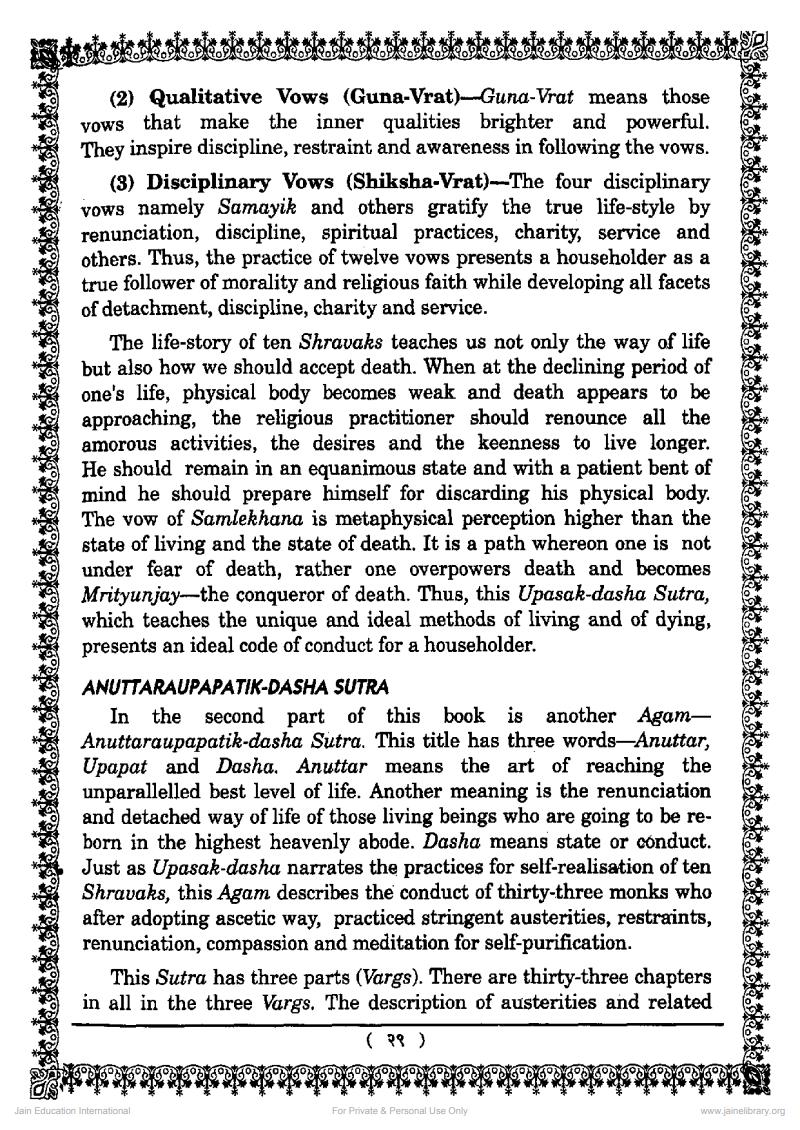RL7ioOraSce~,) O‘RG PROP OMA O DAN OFAN OVAL OTAGO 0 OVISTO PALO PANTO OPAL OVANLO LANL PANO TANTO PANTO DANO PANO PANO LAN eZea1tONe RDPPAAAANNN
G
B
(2) Qualitative Vows (Guna-Vrat)—Guna-Vrat means those C
o
RI vows that make the inner qualities brighter and powerful. o
OP They inspire discipline, restraint and awarenessin following the vows. yr
PRL Lh
o
O i
L (3) Disciplinary Vows (Shiksha-Vrat)—The four disciplinary w
P n
o
Lo vows namely Samayik and others gratify the true life-style by nyr
O
renunciation, discipline, spiritual practices, charity, service and ro
r
as others. Thus, the practice of twelve vows presents a householder as a Om
true follower ofmorality and religious faith while developingall facets
o
a
w
ofdetachment, discipline, charity and service. L
o
a
W
L
The life-story of ten Shravaks teaches us not only the wayoflife
O
but also how we should accept death. Whenat the declining period of M
O
one's life, physical body becomes weak and death appears to be A
D
approaching, the religious practitioner should renounce all the O
L
amorous activities, the desires and the keenness to live longer. O
T
L
He should remain in an equanimousstate and with a patient bent of
O
mind he should prepare himself for discarding his physical body. YL
O
The vow of Samlekhana is metaphysical perception higher than the T
E
state of living and the state of death. It is a path whereon oneis not
YN
under fear of death, rather one overpowers death and becomes O
W
Mrityunjay—the conqueror of death. Thus, this Upasak-dasha Sutra,
O
which teaches the unique and ideal methodsof living and of dying, B
O
presents an ideal code ofconduct for a householder. T
L
O
E
ANUTTARAUPAPATIK-DASHA SUTRA
O
T
In the second part of this book is another Agam— E
O
Anuttaraupapatik-dasha Sutra. This title has three words—Anuttar, N
B
O
Upapat and Dasha. Anuttar means the art of reaching the
L
unparallelled best level of life. Another meaning is the renunciation O
T
R
and detached wayoflife of those living beings who are goingto be re-
O
T
born in the highest heavenly abode. Dasha meansstate or conduct. W
O
L
Just as Upasak-dasha narratesthe practices for self-realisation of ten TA
Y
R
S
Shravaks, this Agam describes the conduct of thirty-three monks who
after adopting ascetic way, practiced stringent austerities, restraints, O
Y
L
renunciation, compassion and meditation for self-purification.
O
R
This Sutra has three parts (Vargs). There are thirty-three chapters O
in all in the three Vargs. The description of austerities and related AWL
O
2
W
D
( %) O
A
W
PODY TOL TORY TOL TOL WTONIA ONY TO PIO LITO DIT ONTO LWaOLWA OLWAONYA ODA O pid Ona Ona Ona Ont’d Ondo TAO
qASI
~w yi
é i 4 Yaeaas




